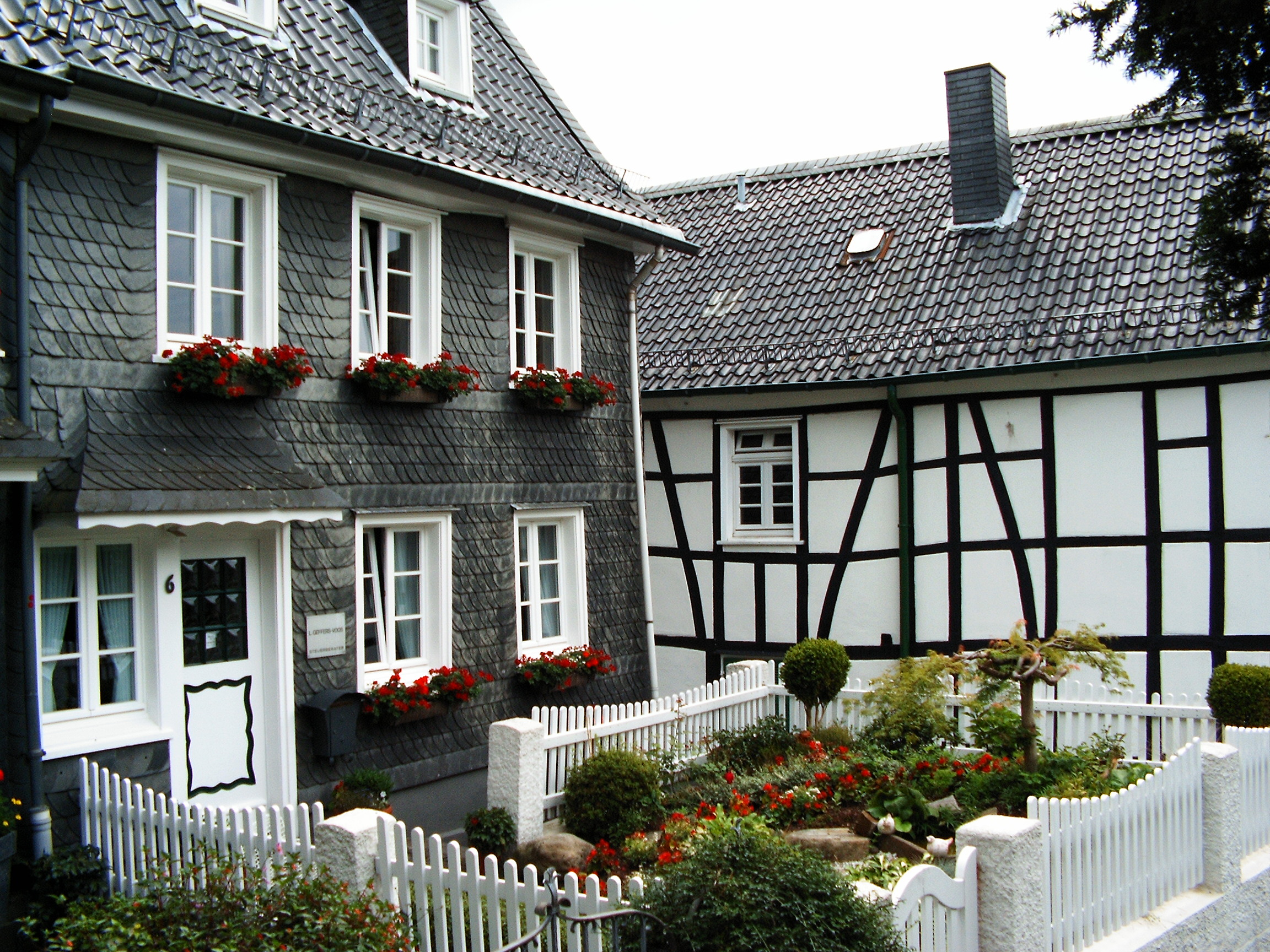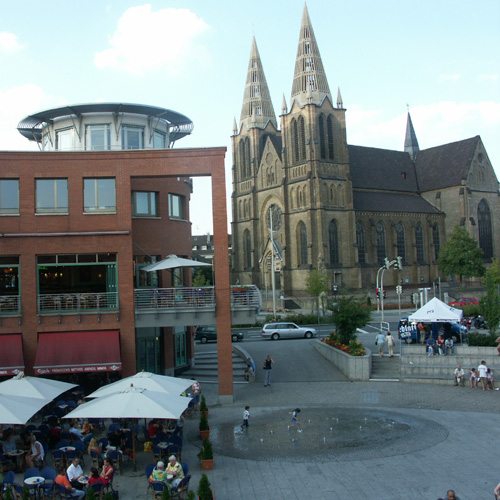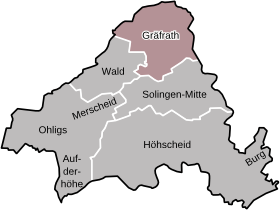|
Trolleybuses In Solingen
The Solingen trolleybus (german: Oberleitungsbus Solingen), also known locally as ''Stangentaxi'', serves the city of Solingen, in the federal state of North Rhine-Westphalia, Germany. Opened on 19 June 1952, it is the largest of the three remaining trolleybus systems in Germany (the others being in Eberswalde and Esslingen am Neckar). The network centres on ''Graf-Wilhelm-Platz'' in Solingen city centre, and one of its lines extends into the neighbouring municipality of Wuppertal. It is operated by Stadtwerke Solingen, the municipal works company. History The first trolleybus route was brought into service on 19 June 1952. The network was a conversion of the previous tram network. Conversion from tramway was completed on 2 December 1959. Extensions to the system were opened in 1981–82 – Schlagbaum to Hasselstraße () and Höhscheid to Brockenberg () respectively – and in 1993 from Aufderhöhe to Mangenberg/Graf-Wilhelm-Platz (). The mid-1990s saw plans to replace the tro ... [...More Info...] [...Related Items...] OR: [Wikipedia] [Google] [Baidu] |
Solingen
Solingen (; li, Solich) is a city in North Rhine-Westphalia, Germany. It is located some 25 km east of Düsseldorf along the northern edge of the region called Bergisches Land, south of the Ruhr area, and, with a 2009 population of 161,366, is after Wuppertal the second-largest city in the Bergisches Land. It is a member of the regional authority of the Rhineland. Solingen is called the "City of Blades", since it has long been renowned for the manufacturing of fine swords, knives, scissors and razors made by famous firms such as WKC Stahl- und Metallwarenfabrik, WKC, DOVO Solingen, DOVO, Wüsthof, J. A. Henckels, Zwilling J. A. Henckels, Böker, Güde, Hubertus, Diefenthal, Puma, Clauberg, Eickhorn, Linder, Carl Schmidt Sohn, Dreiturm, Herder, and numerous other manufacturers. In medieval times, the swordsmiths of Solingen designed the town's coat of arms, which continues to the present. In the latter part of the 17th century, a group of swordsmiths from Solingen broke thei ... [...More Info...] [...Related Items...] OR: [Wikipedia] [Google] [Baidu] |
Wuppertal-Vohwinkel Station
Vohwinkel station is the most western station in the city of Wuppertal. It is located in the district of Vohwinkel. It is a triangular station, built at a railway junction. History The original station was built slightly further west than the present station in 1841 by the Düsseldorf-Elberfeld Railway Company. The Prince William Railway was extended to Vohwinkel in 1848, creating a railway junction. The present building was built at the beginning of the 20th century by the Prussian state railways to the design of Alexander Rüdell. In the early 20th century a three km long marshalling yard was built to the west of the station, but it has since been closed and demolished. In addition to the Düsseldorf-Elberfeld through line and the branch to the former ''Prince William line'' (now the line to Essen), in the past there was a railway line connecting to the now closed Wuppertal Northern Railway and the now closed Corkscrew line from Solingen terminated there. Services No long-d ... [...More Info...] [...Related Items...] OR: [Wikipedia] [Google] [Baidu] |
MAN SE
MAN SE (abbreviation of ''Maschinenfabrik Augsburg-Nürnberg'', ) was a manufacturing and engineering company based in Munich, Germany. Its primary output was commercial vehicles and diesel engines through its MAN Truck & Bus and MAN Latin America divisions, and participation in the manufacturer Sinotruk. MAN SE was majority-owned by Traton, the heavy commercial vehicle subsidiary of automaker Volkswagen AG, until August 2021 when Traton completed a squeeze out of all remaining shareholders and formally merged MAN SE into Traton SE, meaning the former subsidiaries of MAN SE were now directly owned by Traton, and MAN SE ceased to exist. History Foundation MAN traces its origins back to 1758, when the "St. Antony" ironworks commenced operation in Oberhausen, as the first heavy-industry enterprise in the Ruhr region. In 1808, the three ironworks "St. Antony", "Gute Hoffnung" (English: "Good Hope"), and "Neue Essen" (English: "New Forges") merged, to form the Hüttengewerks ... [...More Info...] [...Related Items...] OR: [Wikipedia] [Google] [Baidu] |
Axle
An axle or axletree is a central shaft for a rotating wheel or gear. On wheeled vehicles, the axle may be fixed to the wheels, rotating with them, or fixed to the vehicle, with the wheels rotating around the axle. In the former case, bearings or bushings are provided at the mounting points where the axle is supported. In the latter case, a bearing or bushing sits inside a central hole in the wheel to allow the wheel or gear to rotate around the axle. Sometimes, especially on bicycles, the latter type axle is referred to as a ''spindle''. Terminology On cars and trucks, several senses of the word ''axle'' occur in casual usage, referring to the shaft itself, its housing, or simply any transverse pair of wheels. Strictly speaking, a shaft which rotates with the wheel, being either bolted or splined in fixed relation to it, is called an ''axle'' or ''axle shaft''. However, in looser usage, an entire assembly including the surrounding axle housing (typically a casting) is als ... [...More Info...] [...Related Items...] OR: [Wikipedia] [Google] [Baidu] |
Van Hool
Van Hool NV () is a Belgian family-owned coachbuilder and manufacturer of buses, coaches, trolleybuses, and trailers. Most of the buses and coaches are built entirely by Van Hool, with engines and axles sourced from Caterpillar, Cummins, DAF and MAN and gearboxes from ZF or Voith. Some production involves building bus and coach bodies on separate bus chassis from manufacturers such as Volvo and Scania. Worldwide, Van Hool employs 4,500 people and manufactures more than 1,700 buses and coaches (bodyworks and complete vehicles combined) and 5,000 trailers each year. It sells an average of 600 coaches annually in the United States. History The company was founded in 1947 by Bernard van Hool in Koningshooikt, near Lier, Belgium. In the early years, the company introduced serial production and exported their products all over Europe. Since the mid-1980s, the company has also been active on the North American market. On February 15, 1957, Van Hool signed a commercial agree ... [...More Info...] [...Related Items...] OR: [Wikipedia] [Google] [Baidu] |
VDL Berkhof
VDL Berkhof was a Netherlands based bus and coach builder, founded in 1970 by Arthur Berkhof and his son Henk. It started with only 10 employees in a 1,000 m² factory. During the first 18 months the company only carried out bus repairs. In 1985, the operation moved to a brand new 10,000 m² facility in Valkenswaard. The number of employees was now 132. The factory expanded in 1989 by an additional 10,000 m² resulting in a production capacity of 350 units a year following the acquisition of Hainje. In 1994 Belgium bus and coach manufacturer Jonckheere with a total sales of 400 units per year and 500 employees, was acquired. The total staff number of employees of the Berkhof Groep now reached 1,200. In 1997, the company changed its name from ''Berkhof Groep'' to ''Berkhof Jonckheere Groep''. In 1998 it was bought by the VDL Groep and in 2010 was subsumed by VDL Bus & Coach. The company has also built low-floor articulated trolleybuses for Arnhem in the Netherlands,Murray, ... [...More Info...] [...Related Items...] OR: [Wikipedia] [Google] [Baidu] |
Schloss Burg (Solingen)
Burg Castle (german: Schloss Burg), located in Burg an der Wupper (Solingen), is the largest reconstructed castle in North Rhine-Westphalia, Germany and a popular tourist attraction. Its early history is closely connected to the rise of the Duchy of Berg. Early history At the beginning of the 12th century (after 1133), Count Adolf III of Berg built Schloss Burg on a mountain overlooking the river Wupper. The old castle of the counts, Castle Berge in Odenthal near Altenberg, was abandoned. The original name of the new castle was Castle Neuenberge (Newmountain), or in Latin, novus mons, novum castrum, or novi montis castrum. Not until the 15th century, after significant reconstruction as a hunting castle, did it receive its current name reflecting its palatial extension. His great-grandson, Count Adolf VI of Berg took part in the Fifth Crusade and died during the siege of Damietta in Egypt in 1218. Since the late count had no male descendants his younger brother, Archbishop Eng ... [...More Info...] [...Related Items...] OR: [Wikipedia] [Google] [Baidu] |
Wuppertal Schwebebahn
The Wuppertaler Schwebebahn ("Wuppertal Suspension Railway") is a suspension railway in Wuppertal, Germany. Its original name was ("Eugen Langen Monorail Overhead Conveyor System"). It is the oldest electric elevated railway with hanging cars in the world and is a unique system in Germany. Designed by Eugen Langen and offered first to the cities of Berlin, Munich, and Breslau who all turned it down, the installation with elevated stations was built in Barmen, Elberfeld, and Vohwinkel between 1897 and 1903; the first track opened in 1901. The railway line is credited with growth of the original cities and their eventual merger into Wuppertal. The ' is still in use as a normal means of local public transport, moving 25 million passengers annually, per the 2008 annual report. New rail cars were ordered in 2015, called Generation 15, and the first new car went into service in December 2016. The Schwebebahn runs along a route of , at a height of about above the River Wupper betw ... [...More Info...] [...Related Items...] OR: [Wikipedia] [Google] [Baidu] |
Ohligs
Solingen (; li, Solich) is a city in North Rhine-Westphalia, Germany. It is located some 25 km east of Düsseldorf along the northern edge of the region called Bergisches Land, south of the Ruhr area, and, with a 2009 population of 161,366, is after Wuppertal the second-largest city in the Bergisches Land. It is a member of the regional authority of the Rhineland. Solingen is called the "City of Blades", since it has long been renowned for the manufacturing of fine swords, knives, scissors and razors made by famous firms such as WKC, DOVO, Wüsthof, Zwilling J. A. Henckels, Böker, Güde, Hubertus, Diefenthal, Puma, Clauberg, Eickhorn, Linder, Carl Schmidt Sohn, Dreiturm, Herder, and numerous other manufacturers. In medieval times, the swordsmiths of Solingen designed the town's coat of arms, which continues to the present. In the latter part of the 17th century, a group of swordsmiths from Solingen broke their guild oaths by taking their sword-making secrets with them t ... [...More Info...] [...Related Items...] OR: [Wikipedia] [Google] [Baidu] |
Suburb
A suburb (more broadly suburban area) is an area within a metropolitan area, which may include commercial and mixed-use, that is primarily a residential area. A suburb can exist either as part of a larger city/urban area or as a separate political entity. The name describes an area which is not as densely populated as an inner city, yet more densely populated than a rural area in the countryside. In many metropolitan areas, suburbs exist as separate residential communities within commuting distance of a city (cf "bedroom suburb".) Suburbs can have their own political or legal jurisdiction, especially in the United States, but this is not always the case, especially in the United Kingdom, where most suburbs are located within the administrative boundaries of cities. In most English-speaking countries, suburban areas are defined in contrast to central or inner city areas, but in Australian English and South African English, ''suburb'' has become largely synonymous with what ... [...More Info...] [...Related Items...] OR: [Wikipedia] [Google] [Baidu] |
Gräfrath
Gräfrath or Graefrath is a district of Solingen in the German federal state of North Rhine-Westphalia, about east of Düsseldorf. History There was an abbey An abbey is a type of monastery used by members of a religious order under the governance of an abbot or abbess. Abbeys provide a complex of buildings and land for religious activities, work, and housing of Christian monks and nuns. The conce ... in Gräfrath from 1185 to 1803. In the past, iron, steel, and weaving were important economic activities. References External links Solingen {{Solingen-geo-stub ... [...More Info...] [...Related Items...] OR: [Wikipedia] [Google] [Baidu] |
Solingen Grünewald Station
Solingen Grünewald station is in the city of Solingen in the German state of North Rhine-Westphalia. It is on the Wuppertal-Oberbarmen–Solingen railway. The line through the site of Solingen Grünewald station was opened on 12 February 1890 as part of the Solingen–Wuppertal-Vohwinkel line, known as the ''Korkenzieherbahn'' ("Corkscrew Railway"), to Vohwinkel. The station was opened on 6 May 2006. It is classified by Deutsche Bahn as a category 3 station. The station is served by line S 7 of the Rhine-Ruhr S-Bahn, branded as ''Der Müngstener'', operated every 20 minutes from Monday to Friday and generally every half hour on weekends and at off-peak times, using ( LINT 41) vehicles. Until 15 December 2013 the station was served by Regional-Express service RB 47, operated by DB Regio NRW, normally with two-carriage sets of class 628.4. The Abellio Deutschland company won a contract that was put to tender in November 2010 and took over the operation of passenger services ... [...More Info...] [...Related Items...] OR: [Wikipedia] [Google] [Baidu] |


.jpg)





